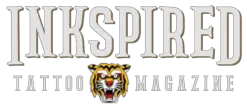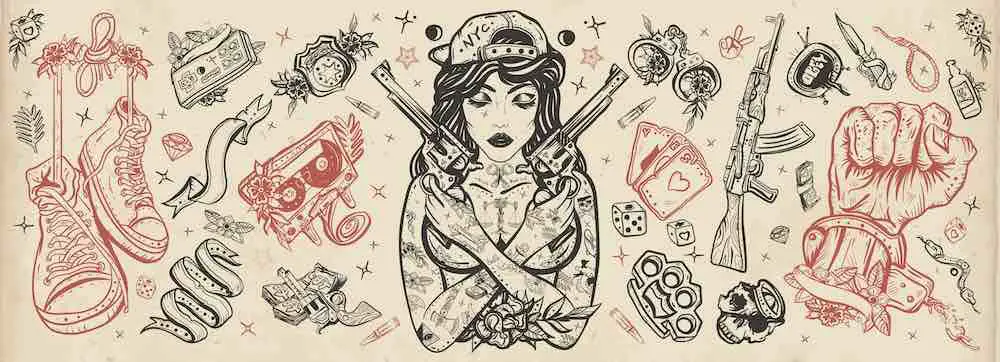Woodcut style tattoos have gained popularity in recent years due to their unique and bold appearance. Inspired by the traditional printmaking technique of carving images into wooden blocks for printing, these tattoos feature intricate designs marked by solid black lines. The style is marked by the use of negative space, with the skin contrasting against the dark ink to create a visually impressive work of art.

One of the key elements of woodcut style tattoos is the attention to detail in the design and execution. Subjects for woodcut tattoos range from nature scenes to skulls and dark imagery, making the style versatile and suited for various personal preferences. When considering a woodcut tattoo, it’s essential to find a skilled artist experienced in working with this technique to ensure the best results.
Key Takeaways
- Woodcut style tattoos are inspired by traditional printmaking techniques and feature bold, intricate designs.
- These tattoos use negative space and solid black lines, making them versatile and suitable for various subjects.
- It’s important to work with an experienced woodcut tattoo artist to achieve the best possible results.
Origin and Inspiration
Woodcut Art in Medieval Times
Woodcut art has a rich history dating back to 9th-century China, where it was used as a means of printing text, images, and patterns. The technique eventually made its way to Europe in the 13th century, where it flourished during the medieval period. The process involves carving a design into a wooden block and removing the non-image areas. The block is then inked, and a print is made by pressing it against a surface.
Transition from Print to Tattoo
The transition of woodcut art from print to tattoo is a nod to the rich history of the craft. Skilled tattoo artists are able to capture the essence and intricacy of woodcut imagery by mimicking the refined line work and bold contrast typical of the traditional technique. Using modern tattoo equipment, they etch designs into the skin with precision, creating visually stunning pieces that celebrate an ancient art form.
Influence of Nature and Landscapes
Woodcut tattoos often draw inspiration from nature and landscapes, as these were common themes in traditional woodcut prints. The intricate detailing and line work required to create these images translate well into the medium of tattooing, allowing for distinct artistic expressions. From detailed portrayals of flora to intricate depictions of intricate landscapes, the woodcut style captures the essence of natural beauty and communicates a sense of tranquility and reverence for the environment.
Key Elements of Woodcut Style Tattoos
Shading and Negative Space
Woodcut style tattoos are known for their intricate shading and the use of negative space. This technique involves using varying degrees of black ink to create depth and texture, while also allowing for negative space to add contrast and highlight details within the design. This is essential in achieving the carved, almost three-dimensional appearance that woodcut tattoos are known for. Shading is often done with precise, thin lines to emulate the look of an actual woodcut print.
Detail and Illustration
The woodcut style is intricate and detailed, which requires a skilled tattoo artist with the ability to create fine lines and precise illustrations. This art form often features natural elements, such as animals, plants, and landscapes, as well as mythological and fantastical creatures. These designs may also include intricate patterns, ornamental motifs, and complex geometric shapes. The level of detail in woodcut tattoos contributes to their realistic appearance while still maintaining the rustic, carved aesthetic that makes them unique.
Color and Skin Tones
While woodcut style tattoos are predominantly created using black ink, there are instances where color can be incorporated to add visual interest and depth. The use of color can be minimal to accentuate certain aspects of the design, or more vibrant for a bolder look. However, it is crucial that the added color complements the overall design, as the woodcut style relies heavily on the precise use of black ink for depth and shading. The artist must also take skin tones into consideration when creating a woodcut tattoo, as different colors will appear differently on various skin tones, and some may not be as effective in achieving the desired effect.
Popular Woodcut Tattoo Themes
Animals and Nature Scenes
Woodcut tattoos often depict animals and nature scenes, showcasing intricate design details and captivating line work. Creatures such as birds, wolves, and deer are common subjects, often accompanied by forest landscapes or other natural elements. This theme allows tattoo artists to demonstrate their skill in creating a woodcut style appearance using these dynamic subjects.
Ships and Skeletons
Maritime themes, particularly ships and skeletons, are another popular choice for woodcut tattoos. These designs often feature intricate rigging, sails, and hulls, as well as the skeletal remains of sailors or pirates. The aged and rustic quality of woodcut style tattoos pairs well with these nautical subjects, resulting in unique and meaningful body art.
Skulls and Angels
Skulls and angels are frequently combined in woodcut tattoos, with artists using the stylistic elements of woodcut prints to create captivating designs. The interplay between life and death, darkness and light, is beautifully represented in this pairing. Additionally, woodcut tattoos can highlight the detailed bone structures and anatomy found in skulls, alongside the ethereal elegance of angelic figures.
Flowers and Landscapes
The woodcut style lends itself well to depicting flowers and landscapes, creating stunning tattoo designs. These tattoos often feature elaborate details of petals, leaves, and natural vistas, capturing a timeless appeal. From mountain ranges to sprawling meadows, woodcut landscape tattoos offer endless possibilities for those looking to immortalize a special place or moment on their body.
Finding and Working with a Woodcut Tattoo Artist
Selecting the Right Artist
When searching for a woodcut tattoo artist, it’s essential to find someone who has experience and expertise in this specific style. Begin by researching local tattoo artists and checking their portfolios for examples of woodcut tattoos they’ve done in the past. Social media platforms like Instagram can also be helpful in discovering artists who specialize in woodcut designs. Keep in mind the following points when selecting the right artist for your tattoo:
- Experience: Choose an artist with a proven track record in woodcut tattoos.
- Portfolio: Ensure their portfolio showcases a variety of woodcut designs, demonstrating their versatility and skill.
- Style: Each artist will have their unique take on the woodcut style; find one that resonates with you.
- Communication: The tattoo artist should be open to discussing your ideas and providing guidance on how to achieve the desired result.
Collaborating on Tattoo Design
Once you’ve found the perfect woodcut tattoo artist, the next step is to collaborate on your desired design. Effective communication with your artist is crucial to ensure you’re both on the same page regarding the final outcome. Here are some tips for collaborating on tattoo design:
- Share your ideas: Provide references or examples of woodcut designs you like. This will give your tattoo artist a better understanding of your desired style and elements.
- Be open to suggestions: Artists have a wealth of experience and may offer suggestions on how to enhance your design or make it more suitable for a tattoo. Trust their professional judgment.
- Discuss placement and sizing: Woodcut tattoos can look great on various parts of the body, but some designs may work better in specific areas. Talk with your artist about where the tattoo would look best and the ideal size for your chosen design.
- Review sketches and drafts: Before committing to the final design, ask to see a sketch or draft. This allows for any necessary adjustments or changes to be made before starting the tattooing process.
By carefully selecting an experienced woodcut tattoo artist and collaborating on an ideal design, you can achieve a stunning work of art that will stand the test of time. Remember to communicate openly, trust your artist’s expertise, and enjoy the process of creating your unique woodcut tattoo.
Etching and Other Related Tattoo Styles
Etching Tattoo Style
Etching tattoo style is a relatively recent development in the tattoo world, inspired by the centuries-old technique of etching in printmaking. Dating back to the 15th century, etching involves carving designs into a metal plate, usually with the use of special tools. Similarly, etching tattoos utilize sharp lines and focused details to create captivating imagery. These tattoos are often black and white, effectively mimicking the stark contrast found in traditional etchings.
Comparing Woodcut and Etching Tattoos
Woodcut tattoos, on the other hand, have their origins in woodcut printing, a different form of printmaking. As the name suggests, these designs are created by etching a picture into a wooden block. Woodcut tattoos capture the essence and aesthetic of woodcut prints, often featuring bold lines and minimalistic shading.
While both etching and woodcut tattoo styles share a connection to historical printmaking techniques, they differ in their visual approach. Etching tattoos tend to emphasize intricate details and precision, whereas woodcut tattoos are characterized by strong, simple lines and a more rustic appearance. Regardless of the distinctions between these styles, both offer an opportunity for those who appreciate traditional art forms to adorn their body with a truly unique and meaningful design.
Frequently Asked Questions
What is the origin of woodcut style tattoos?
Woodcut style tattoos are inspired by the ancient art of woodcut printing. This technique involves etching a design into a wooden block, which is then inked and pressed onto a surface to create a print. The style has been adapted for tattooing to create a similar aesthetic, with artists replicating the distinctive lines and shading found in woodcut prints.
How does aging affect woodcut tattoos?
Woodcut tattoos, like all tattoos, will age and their appearance may change over time. Factors such as sun exposure, skin type, and the quality of the ink can impact how well a tattoo ages. To maintain the best possible appearance, it is essential to follow proper aftercare instructions and regularly apply sunscreen to protect the tattoo from UV exposure.
Which artists specialize in woodcut tattoos?
Several tattoo artists specialize in woodcut styles. To find the right artist for your specific needs and preferences, it’s best to research and browse through portfolios. Instagram and online tattoo galleries can be helpful resources to find artists who excel in woodcut style tattoos.
What are some popular woodcut tattoo ideas?
Popular woodcut tattoo ideas often include nature motifs, such as flora and fauna, as well as mythological and historical themes. Some examples are intricate botanical designs, animal portraits, and famous artwork interpretations. Personal preferences and symbolism play a significant role in determining the ideal woodcut tattoo for an individual.
How does woodcut style differ from etching style tattoos?
While woodcut and etching styles look similar, their origins and techniques differ. Woodcut tattoos are inspired by woodcut prints created using hand-carved wooden blocks, while etching style tattoos draw inspiration from etched metal plates. Etching tattoos tend to have a finer, more delicate appearance compared to the bold lines and solid shading characterized by woodcut tattoos.
What is the main difference between old school and new school woodcut tattoos?
Old school woodcut tattoos typically focus on traditional subjects and themes, such as historical events, mythology, and folklore. They also emphasize the classic woodcut printing aesthetics, with bold lines and high contrast. New school woodcut tattoos, on the other hand, can incorporate more modern and creative elements, blending the traditional style with contemporary designs and subject matter.


